Shin Megami Tensei: Strange Journey Redux (Nintendo 3DS) Review
By Renan Fontes  16.05.2018
16.05.2018
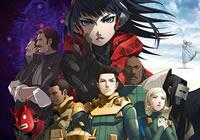
Of all the games to remaster for the franchise's 25th anniversary, Strange Journey is perhaps, for lack of better word, the strangest choice imaginable. The story isn't set in Tokyo, the main character is a grown man, and the series' trademark Press Turn system is swapped out in favour of more traditional JRPG battle mechanics. There's also the question of whether or not SJ is actually a spin-off title due to its lack of staples. Regardless of whether or not it's an "official" part of the mainline canon, it does bear the Shin Megami Tensei name and was selected by Atlus to celebrate two and a half decades of games. It may not be the most conventional choice, but it's one that shows off the series' variety while also displaying its core spirit.
Mainline Shin Megami Tensei titles have a habit of either starting out in Tokyo shortly before the end of the world, or having their main characters make their way to Tokyo later on. It's a setting that's almost synonymous with the series, so Strange Journey's decision to abandon the city in favour of Antarctica is a bold one that adds some much needed geographical freshness to the franchise. It should be noted that while the story does explicitly take place on Antarctica, it's more appropriately set within the Schwarzwelt: a black hole slowly engulfing the Earth.
Although other games in the series have shown the world before the apocalypse, most notably the original Shin Megami Tensei for the Super Famicom and Shin Megami Tensei: Nocturne for the PlayStation 2, Strange Journey is the first main entry to set itself firmly in the before state. It could be argued that not showing the aftermath of the collapse of society removes some of the series' darkness, but there's something all the more morbid about being caught in the midst of the apocalypse and being held directly responsible for its prevention.
Like with Tokyo, every single game in the main series stars a teenage boy in the lead role. It's arguably a key facet of the franchise's identity and one that even extends into the Persona sub-series, (Persona 2: Eternal Punishment and Persona 3 Portable notwithstanding.) In yet another shake-up, the young male lead archetype has been replaced with a grown man, a soldier at that. To further differentiate him from the protagonists who came before, the main character is even American instead of Japanese in the localized script. This is easily the best "twist" on the standard formula as an older main character naturally brings an older supporting cast.
Even though the age of a cast is in no way indicative of the quality of a story, it is nonetheless nice to have a more inherently mature take on the Shin Megami Tensei narrative. Seeing the end of the world through the eyes of adults instead of teenagers paves the way for darker themes. The cast is older, and they act older. They mention real adult fears, like wanting to survive their mission so they can see their daughter. These are characters with inherently deeper histories given their age, and the military premise adds another layer. Four of the six principal characters are all soldiers and that alone creates a unique dynamic amongst the cast.
Where Strange Journey changes up the basics of the setting, the ideological core is still present. Each mainline Shin Megami Tensei game involves the main character answering questions during the story to affect their alignment. Though some games put their own twist on the alignment formula, SJ sticks to the standard Law, Neutral, and Chaos trinity. Answering in a way that demonizes demons, glorifies God or angels, or just simply feels "lawful" skews the player character towards Law; siding with a demon's point of view, answering critically of God, or acknowledging humanity's faults skews towards Chaos; and answering in humanity's best interest or just not siding with either the angels or demons keeps the main character Neutral.
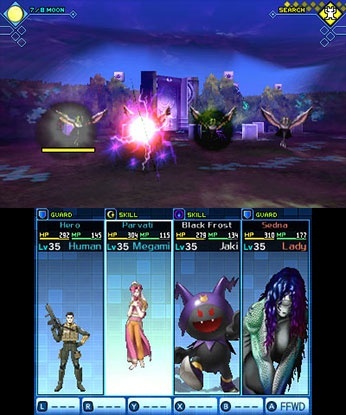
As to be expected from the series, the main character's alignment ultimately affects the end of the game. In this case, it also slightly changes up the final dungeon and the final boss in one specific route. There is a twist, however. This time around, alignment doesn't just affect the story- it affects the gameplay, too. Usually, the main character can compose a party of whatever demons he wants. Here, he needs to be mindful of whether or not his alignment is compatible with his party. A party can be made up without taking alignment into consideration, but it ends up hindering the Demon Co-Op system.
Instead of using the traditional Press Turn system where targeting an enemy's weakness offers the player an additional turn, triggering a weakness forces a Demon Co-Op attack where everyone attacks the enemy at once so long as they're all the same alignment. If the main character is aligned Neutral and his entire team is Neutral then everyone will attack all at once to trigger a level 3 Demon Co-Op attack. Should someone in the party be Law, though, they'll be excluded from the co-op and the joint attack will do less damage.
On one hand, the Demon Co-Op system isn't as exciting or rewarding as the Press Turn system. On the other hand, it incentivizes creative and more strategic play due to the fact it forces the main character to use demons he otherwise might not. Doing well in the Schwarzwelt isn't a matter of just building a team of what demons are strongest. It's important to compose a team with alignment in mind in order to take advantage of Demon Co-Op attacks as much as possible. The former might work well as a tactic for random encounters, but it'll undeniably flounder in the latter half, especially against bosses.
While the alignment system's integration into the battle system will change up how series veterans approach party building, recruiting demons for the party will be familiar territory. Demons can either be recruited by being talked to during battle or by fusing demons already in the main character's roster. Of the two, recruiting demons via conversation will likely happen more frequently. Although not easy, especially early on, it is the most reliable way of building up a roster, even if just to use as fusion fodder later. Talking to demons involves answering their questions in a way so not to anger them and then later negotiating by either accepting their requests to take the main characters' items, health, or energy. Since there's overlap to demon conversations, it's important to read each one carefully in order to familiarize oneself with the demon's responses. Recognizing a speech pattern can save and will a lot of time in the negotiation process.
There are two types of fusion: regular fusion and special fusion. In regular fusion, two demons can be merged together to make a new demon. This new demon inherits a set of fixed skills from its sources, but it can also be fully customized with a Demon Source. Demons who have been fully analyzed and level up will reward the main character with their sources. These sources hold a skill set that can then be used when fusing a new demon. Instead of just adding those skills to the demon's roster, though, the main character can take advantage of a source to edit the new demon's move set. Just like with the Demon Co-Op system, Demon Sources encourage the use of demons that would otherwise be forgotten, if only for their sources.
Special fusion works much in the same way, but the end result demons must be unlocked either through the main story or EX-missions. Upon unlocking a new demon, the main character can then fuse them so long as they have the required demons in the compendium. Some special fusion demons only require the standard two to fuse while others can require upwards of eight unique demons to pull off. It goes without saying that the key to a successful party is fusing as much as possible in order to beef up the compendium.
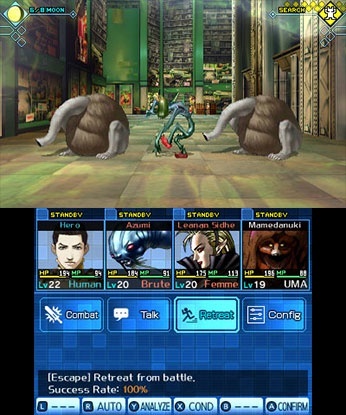
Although the protagonist is given all the tools he needs to survive the Schwarzwelt, there are nonetheless going to be roadblocks along the way. Strange Journey is a dungeon crawler at its core, and it shows. If the bosses don't end up posing much of a challenge, which they more than likely will, the dungeons will more than make up for them. Starting from the second sector on, the Schwarzwelt starts to show its crueller side. Each area has its own aesthetic and set of gimmicks, so to speak, to separate it from the rest. Sector Bootes is a red-light district with a massive eight story palace filled with poison floors and pitfalls; Sector Carina is a shopping mall that requires plane shifting in order to change the layout of the area; and Sector Delphinus is a junkyard that utilizes one-way conveyor belts to make progress.
The dungeons in the later half, especially, drop all pretence of core gimmicks and start to adopt several different dungeon crawling staples such as dark rooms and warp panels into one perfect blend. The dungeons can be frustrating at times, and will be for inattentive players, but they're incredibly rewarding to explore and never feel unfair. Some are much harder than others, with Sector Eridanus being the standpoint in terms of dungeon design, but this challenge is important both gameplay-wise and narratively. Shin Megami Tensei games are meant to be hard and the dungeons here reflect that. It's certainly overwhelming, especially later on, but never impossible and never out of reach. Rather, it demands critical thinking and an attention to detail. From a narrative standpoint, the Schwarzwelt is introduced as an oppressive environment that will slowly consume the entire planet; it's only natural the gameplay reflect that hostility.
If the challenge is proving too much, there are Sub-Apps that the main character can purchase to augment his Demonica. The original game had a fair share that helped in alleviating the difficulty, but they were restricted so the main character had to pick and choose his apps carefully. Redux removes that restriction entirely in favour of a free-for-all system. This does remove much of the strategy present in the original Sub-App system, but it does make for a less tedious experience, especially in the back half once the dungeons become far more demanding. All things considered, this is a change for the better. It could have perhaps been balanced to include the restriction, but that's neither here nor there.
On top of a less restrictive Sub-App system, the difficulty can be lowered at any time outside of battle. This allows for much quicker grinding along with the ability to speed up battles or outright skip the animations. The gameplay is designed with the Standard difficulty in mind, but grinding on Casual while skipping battle animations is far more tolerable than doing in on Standard. It also allows newcomers to continue to make progress where they otherwise may have gotten stuck. It removes some of the "hardcore" vibe Shin Megami Tensei is known for, but it's done entirely at the discretion of the player and can be easily ignored.
The last major addition Redux adds to the gameplay are the inclusion of Commander and Auto Skills. As the main character cannot access magic by traditional means or manually choose his stats when levelling up, these two skill sets have been added to make him more useful. Commander Skills effectively serve as buffs that can be activated at the beginning of his turn. Instead of using MP, they have a cool down. Auto Skills randomly occur at the beginning of each turn and seem to be tied to the main character's luck, giving the stat some more importance as well. Like with Commander Skills, Auto Skills serve as general buffs but they're generally a bit more useful. While the Skills can offset the main game's balance, they do work rather well with the bonus content.
After making some progress into Sector Bootes, the main character will be confronted by Alex, an all new character designed specifically for Redux. Forcing new characters into remasters has been a trend of Atlus' for a while now, but Alex is easily the best iteration of the concept, especially in hindsight. Her inclusion in the story is completely justified and honestly makes for a better narrative. Her relationship with her AI unit, George, also works surprisingly well and the two play off each other in an endearing, often menacing way. Upon encountering Alex for the first time, the main character gains access to the Womb of Grief, a new dungeon tied to three new endings.
The Womb of Grief is made up of six spheres and progress is tied to a quest given by another new character, Demeter. Although written a bit worse than Alex, her dialogue standing out as rather one dimensional, Demeter does end up playing an interesting role in the revised story and her inclusion feels natural, writing aside. Her quest involves hunting down six pieces of fruit for her "Harvest." Each piece is located at the end of the each sphere and accompanied with a boss fight. For balance's sake, it's best to tackle each sphere alongside each new sector. The spheres themselves require Main Apps from progressing normally so there are lockouts at the end of each sphere if enough of the main game hasn't been completed. By alternating between the Womb of Grief, the main character can make good use of the new demons and Sub-Apps it offers. On top of that, the Womb of Grief serves as a nice pace breaker from the main plot.
Upon clearing all six spheres, the main game will continue normally all the way to the final boss. After "finishing" the game, however, the story will continue into a new dungeon with a new final boss. Depending on the main character's alignment, the ending they would have normally gotten will be added upon instead of outright changed. Effectively, the new story content serves as an epilogue of sorts. It is possible to ignore the Womb of Grief entirely in order to get the original endings, but Alex is now tied to the base story and her presence cannot be ignored. Not that it should as she's actually quite a compelling character and her boss fights in the Womb of Grief stand out as some of the best in the game.
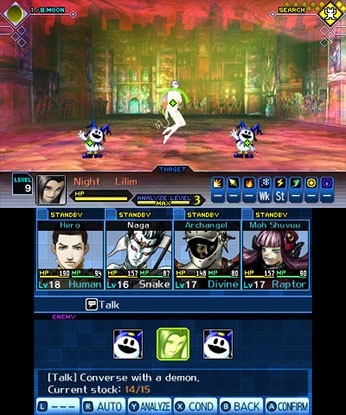
Taking all six spheres and the new final dungeon into consideration, the Womb of Grief is easily the hardest dungeon in Strange Journey. It makes use of just about every puzzle possible in the format and reuses many of the gimmicks found in the base Sectors while adding new ones for variety. Conveyor puzzles, warp puzzles, invisible walkways, and plane shifting all work together to create an unapologetic dungeon that pushes the player to their absolute limit. The puzzles here are legitimate brainteasers and require an intense amount of attention to complete. They're well worth doing so, though, as the new endings tied to the Womb of Grief greatly improve upon the original Law and Chaos ending, making them actual viable alternatives to Neutral in a narrative sense, while adding an interesting twist to the typical Neutral ending formula.
Despite improving upon the gameplay and story, Redux is worse than Strange Journey in the art department. Kaneko's art added a lot of charm to the original's tone and the redesigns are, on a whole, worse. That said, the inclusion of voice acting is a plus and the updated visuals make for a far more immersive dungeon crawling experience. Along with some new music tracks, SJ manages to retain its stellar atmosphere. Shin Megami Tensei thrives in darkness and Strange Journey pushes that to an extreme in every department, especially narratively.
The plot isn't just about stopping the Schwarzwelt, it's an examination of humanity's worth. That tends to be the case for every mainline SMT, but it feels more poignant here. Mankind is inherently self destructive and seeing that destruction within each Sector is a reminder of the evil humanity is capable of. It's pointed, not ham-fisted, and the characters reflect that. Both Jimenez and Zelenin embody Chaos and Law respectively, and they have good reasons for doing so that tie into their arcs and ideologies. More than with any game in the series, it's easy to see the merit in each alignment, especially when taking the new endings into account.
The second half of the story ramps up the drama considerably, offering one of the more emotional and high stakes narratives in the series. Uncovering the truth of the Schwarzwelt and then deciding what to do with it is paced perfectly, giving control to the player whenever necessary while also allowing them to genuinely reflect on what would be best for the world. There are no easy answers in Strange Journey, but there are no easy answers in life, either. It's hard to see humanity at its most vulnerable and most disgusting, but it makes for an immensely compelling plot with a cast worth caring about.
Strange Journey is an odd game to celebrate the series' 25th anniversary with, but its sheer amount of quality mitigates that notion entirely. Shin Megami Tensei: Strange Journey Redux is a triumph in dungeon crawling and storytelling, changing up just enough from the main series for the sake of variety without forgetting what makes the franchise so special. It's an unconventional celebration, but it's a wonderful one nonetheless.
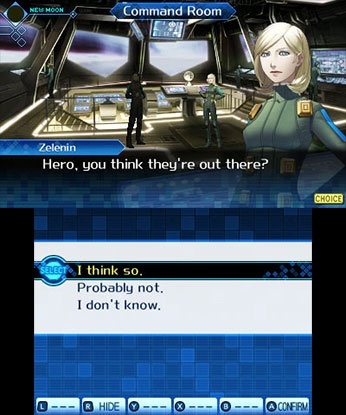
Cubed3 Rating
Masterpiece - Platinum Award

Already a phenomenal game in its own right, Redux makes Strange Journey all the better with gameplay and narrative additions that only serve to enhance what was already present. Alex's presence in the plot adds an extra layer of tragedy to what was already one of the darkest stories in the franchise, and the Womb of Grief is one of the best dungeons in the series, offering a variety of fantastic new bosses, demons, and side-quests to play around with. The lack of Kaneko's original art is certainly a detriment to the overall aesthetic, but the base gameplay and dungeons have been left untouched, ensuring the core experience doesn't stray from the original's vision. Along with being the definitive way to play Strange Journey, Redux stands out as one of the best games in the Shin Megami Tensei franchise all around.
Comments
Comments are currently disabled

 Sign In
Sign In Game Details
Game Details
 Out now
Out now  Out now
Out now  Out now
Out now  Out now
Out now  Subscribe to this topic
Subscribe to this topic Features
Features





 Top
Top

